Our Verdict
The MSI MAG Z790 Tomahawk Wi-Fi is proof that you don't need to spend really big bucks on a Z790 board unless you must have a specific feature. Other than missing out on a PCIe 5.0 M.2 slot, it's got just about everything you should realistically need.
For
- Well balanced feature set for the price
- Excellent VRM
- Seven SATA ports
- Excellent connectivity options
Against
- No PCIe 5.0 M.2
- VRM heatsinks could be better
- Behind the best at memory overclocking
PC Gamer's got your back
MSI's Tomahawk motherboards usually rate highly. They tend to focus on a core feature set rather than the premium tier features common to much more expensive boards. If the bells and whistles don’t matter to you, but you still want something capable of driving a demanding Core i9 13900K CPU, then Tomahawk models will probably be on your radar.
The MSI MAG Z790 Tomahawk WiFi—as the name suggests—is a part of MSI's MAG range, its second tier sub brand. It sits above the Pro range and below the MPG and high-end MEG range. At $319 / £337 / AU$569 it's not cheap, though compared to what some premium tier boards are selling for, it's not badly priced at all. There's tough competition from the other vendors in its price range though.
Here for review I have the DDR5 version. There's also a DDR4 version should you have a good set of DDR4 memory on hand, though if you need to buy memory too, the DDR5 version is definitely the way to go. DDR4 is very much at the end of its life and the 13th Gen platform is almost certainly its last hurrah.
The Tomahawk adopts a tried and true all black theme, with plenty of brushed metal heatsinks. It lacks onboard RGB, though you get four headers, three of which are addressable. Personally, I prefer this kind of subtler design to ones that present you with overt RGB advertisements every time you peer into your case.
Socket: Intel LGA1700
CPU compatibility: Intel 12th & 13th Gen desktop processors
Form factor: ATX
Memory support: DDR5-7200+(OC), Up to 128GB
Storage: 4x M.2, 7x SATA
USB: Up to 1x USB 3.2 Gen2x2, 6x USB 3.2 Gen 2, 6x USB 3.1 Gen 1, 6x USB 2.0
Display: 1x DP 1.4. 1x HDMI 2.1
Networking: Intel 2.5G LAN, Intel Wi-Fi 6E
Audio: Realtek ALC4080
Price: $319 / £337 / AU$569
The Tomahawk includes support for four M.2 drives, though PCIe 5.0 SSD support is missing. Would it be nice to have? Yes, but along with a total lack of PCIe 5.0 drives, the Z790 platform requires an 8x/8x split between the 16x primary slot and the M.2 slot, meaning it's not something that's vital to have at this point in time. A good quality PCIe 4.0 drive will be more than sufficient for years to come, much like a good PCIe 3.0 drive still remains relevant today.
Unlike some PCIe 5.0 SSD supporting boards, such as the more expensive Gigabyte Aorus Z790 Master with its massive M.2 heatsink, the Tomahawk doesn’t need one, sticking with a low profile design that doesn’t require lots of surface area.
The Z790 Tomahawk comes with seven SATA ports. For bulk storage, SATA still has a place and those seven ports alone may be a deal maker for some users. Some boards costing a lot more come with only four SATA.
The VRM is a real highlight compared to competing offerings in its price range. A 16+1+1 phase solution with 90A stages is easily capable of pushing an overclocked Core i9 13900K. However, you’ll need to make sure you have active airflow over the heatsink area as they don’t have a whole lot of surface area. While looping Cinebench R23 on a Core i9 13900K without power limits, I saw a peak VRM temperature of 69°C. That's okay but in a closed case with poor airflow, temperatures will rise a lot more than that. Less demanding i5 and i7 CPUs will fare a lot better of course.
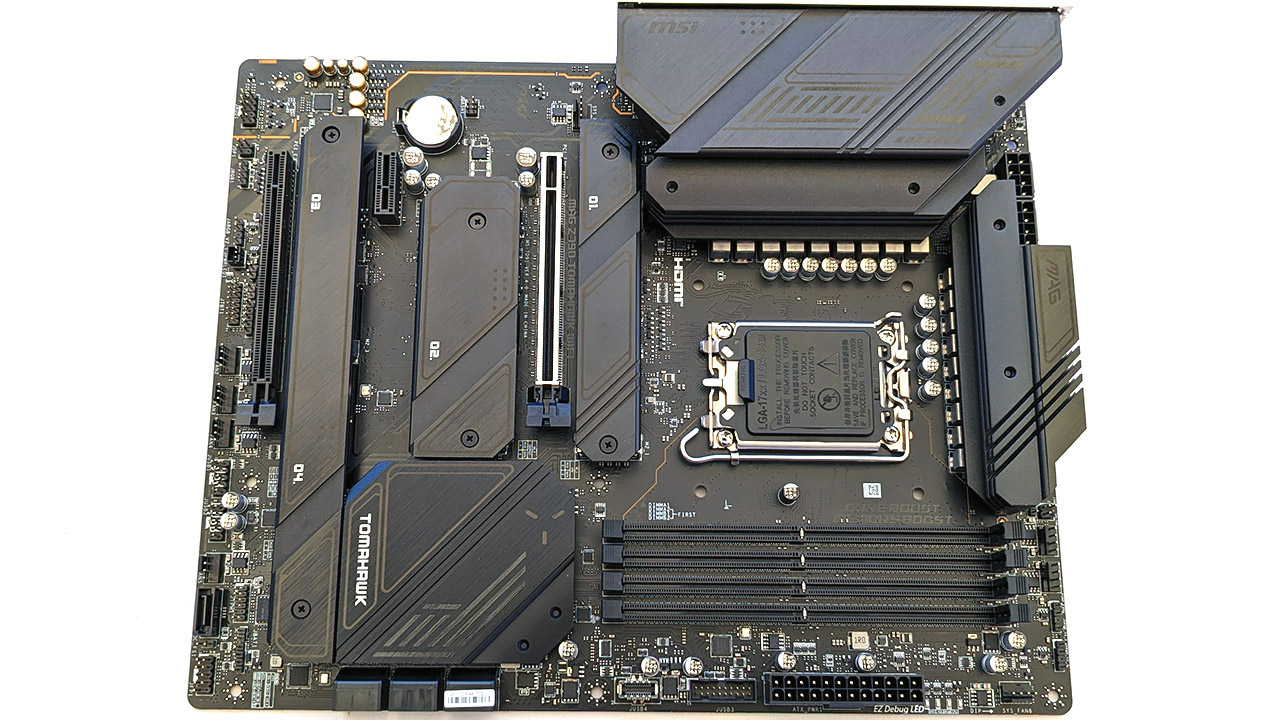
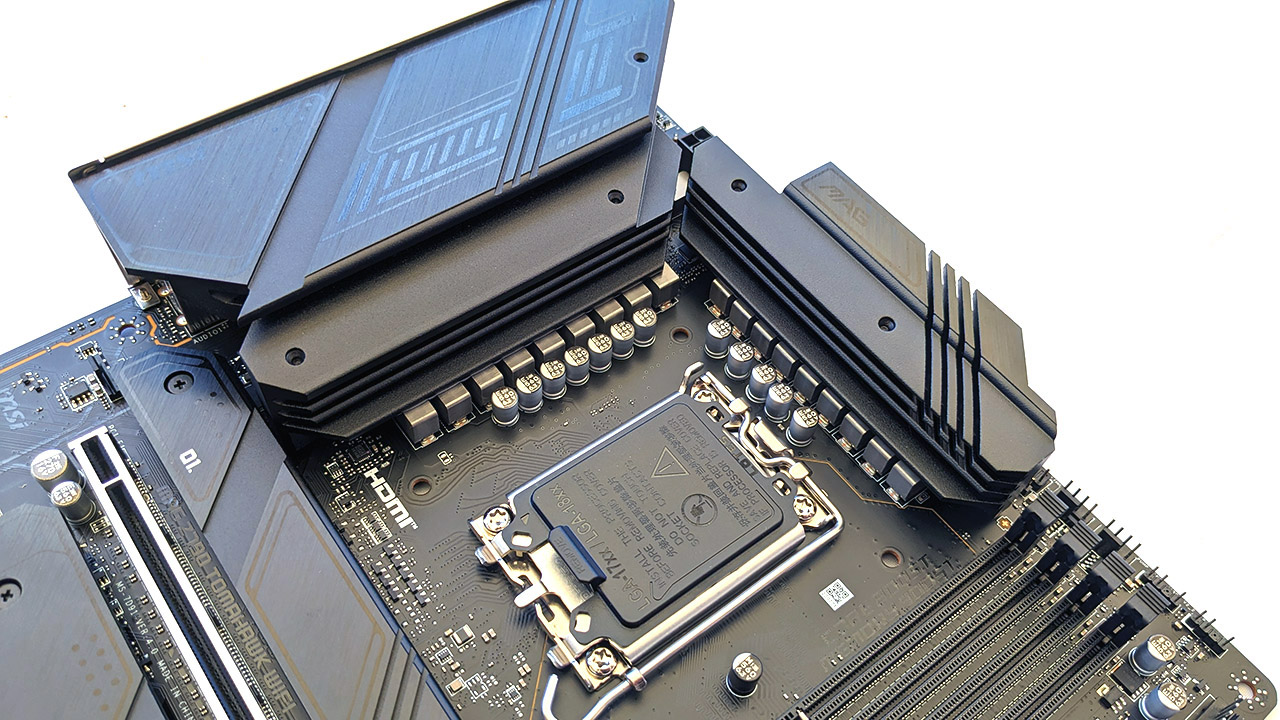
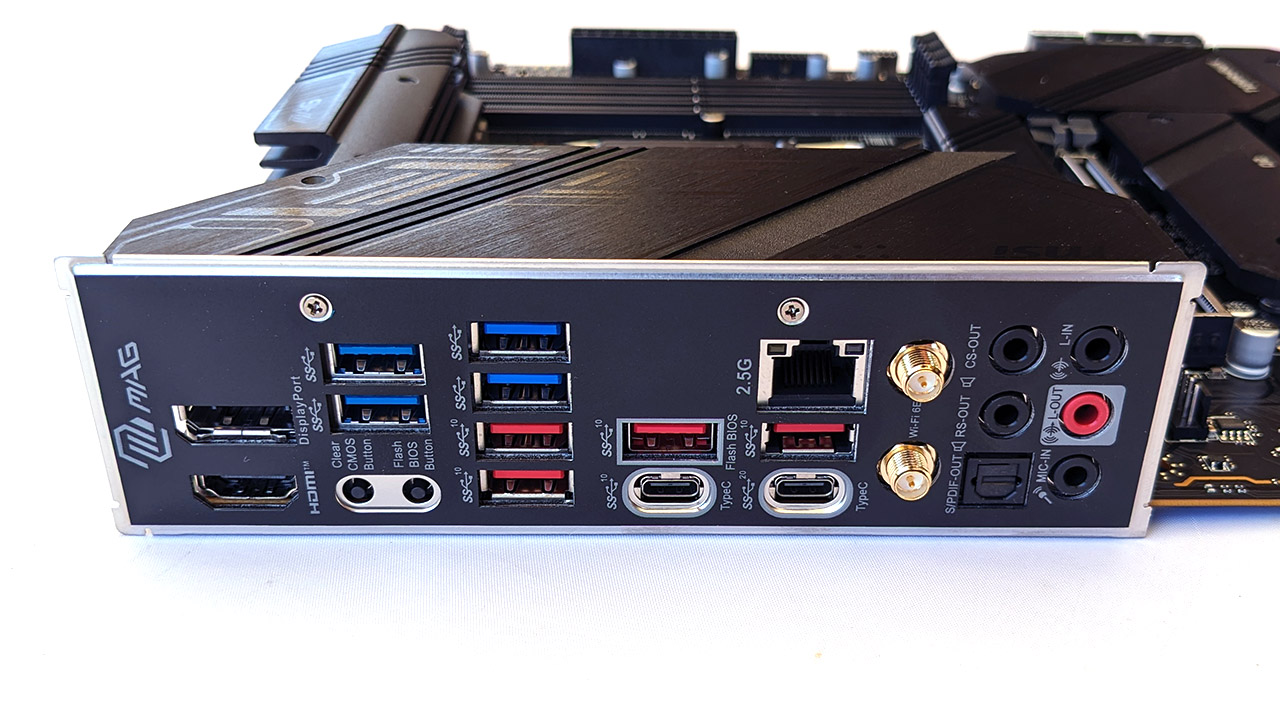
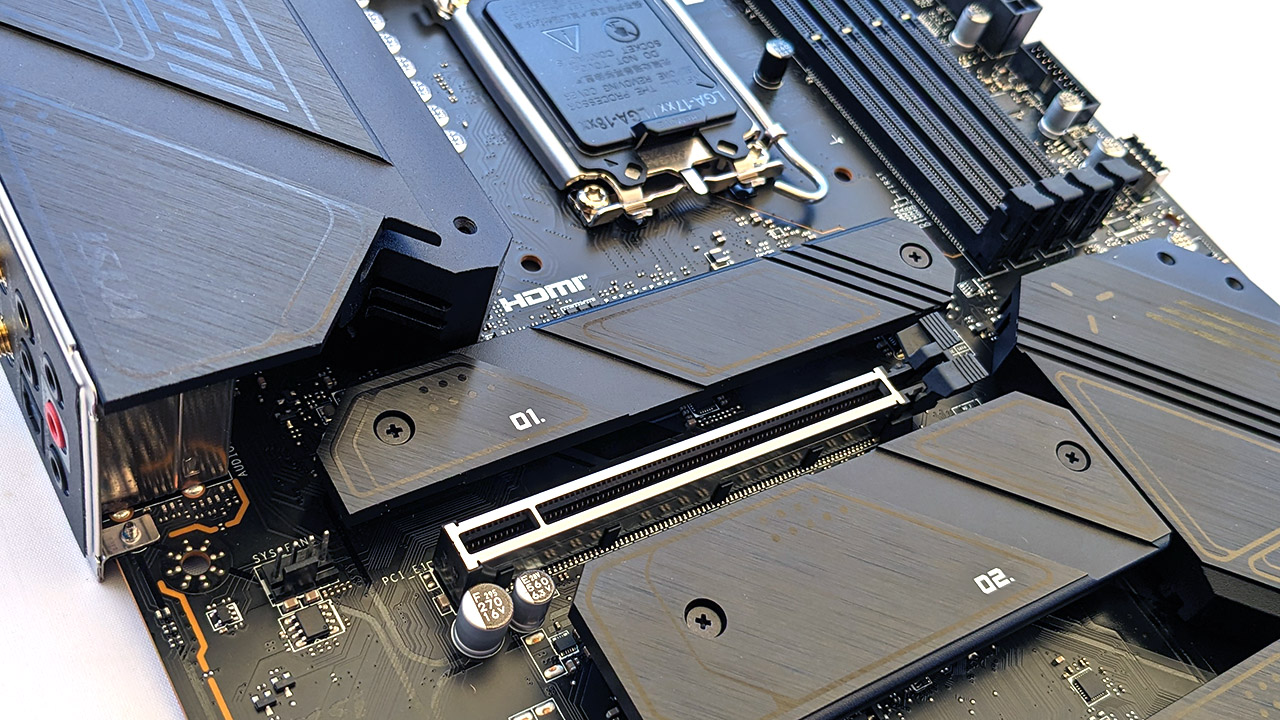
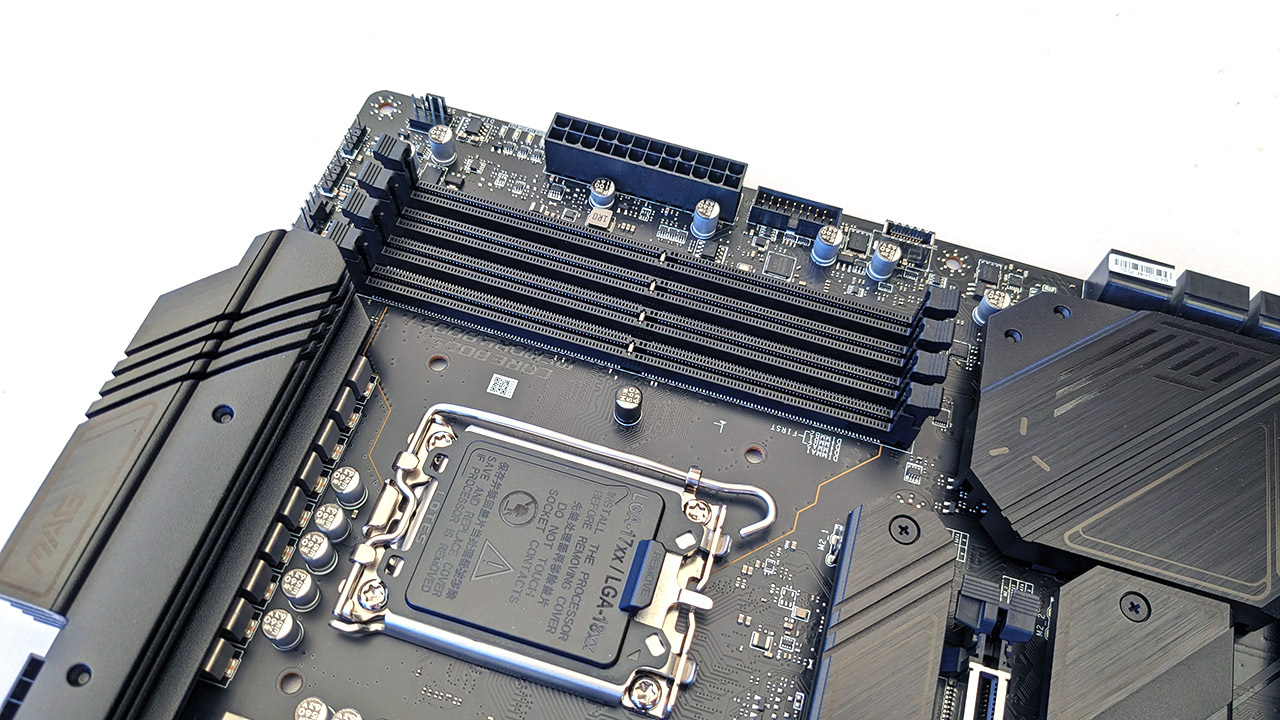
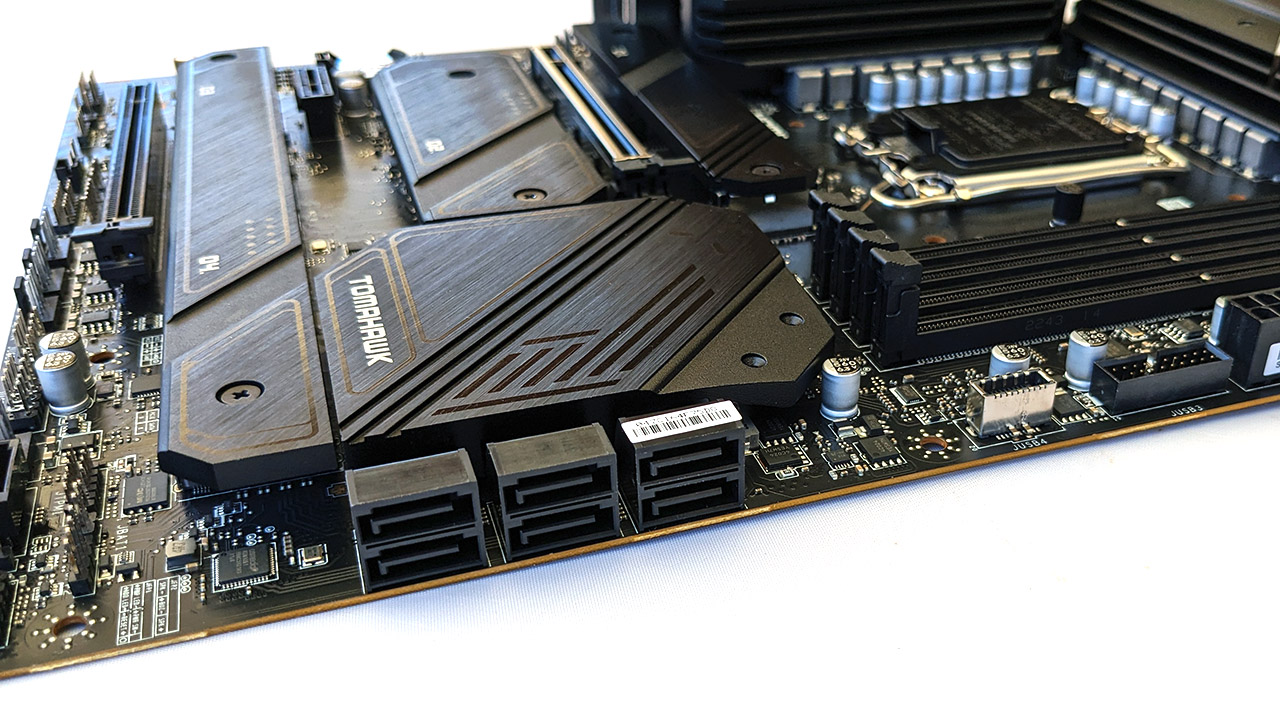
The rear I/O is particularly impressive, with a total of ten USB ports, topped by USB 3.2 Gen 2x2 and Gen 2 Type-C ports. Add to that another four USB Gen 2 ports and four Gen 1 ports. There's 2.5G LAN and Wi-Fi 6E, a full set of audio ports powered by a Realtek ALC4080 codec, CMOS and BIOS flash buttons, and finally HDMI 2.1 and DP 1.4 ports.
That’s a very well-rounded set of options, especially at this price where USB4 or Thunderbolt 4 is not expected. They’re the kinds of features that makers use to justify boards costing twice as much.
MSI's BIOS has changed little over the years, and honestly, it doesn't need to. If you're familiar with MSI boards since their first UEFI iterations, you'll be right at home. Though everyone will have their own opinions on which layout they prefer, MSI's interface gets my pick. I particularly like MSI's fan control system. I hate to leave my system's fans at auto.
You could say I'm a fan... I’ll show myself out.
The MSI BIOS presents you with a simplistic CPU TDP selection upon first boot. There's a default 'Boxed Cooler' setting which enforces Intel's power limits, a 'Tower Cooler' option which raises TDP to 288W, and finally a 'Water Cooling' option which removes all limits. Not that you'll ever need it, but this allows a hypothetical 4096W!
System Performance
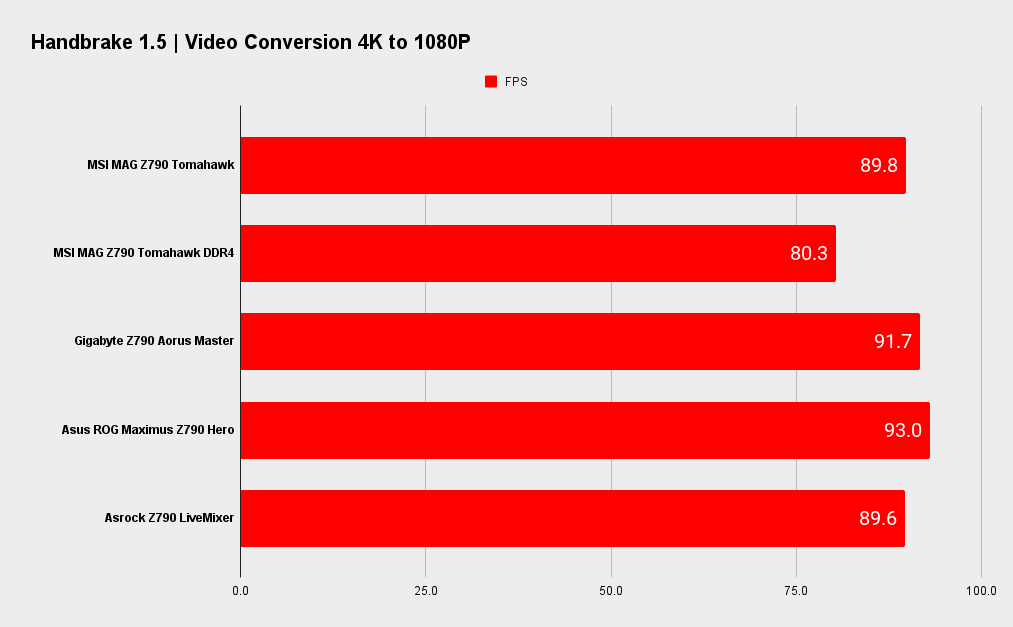
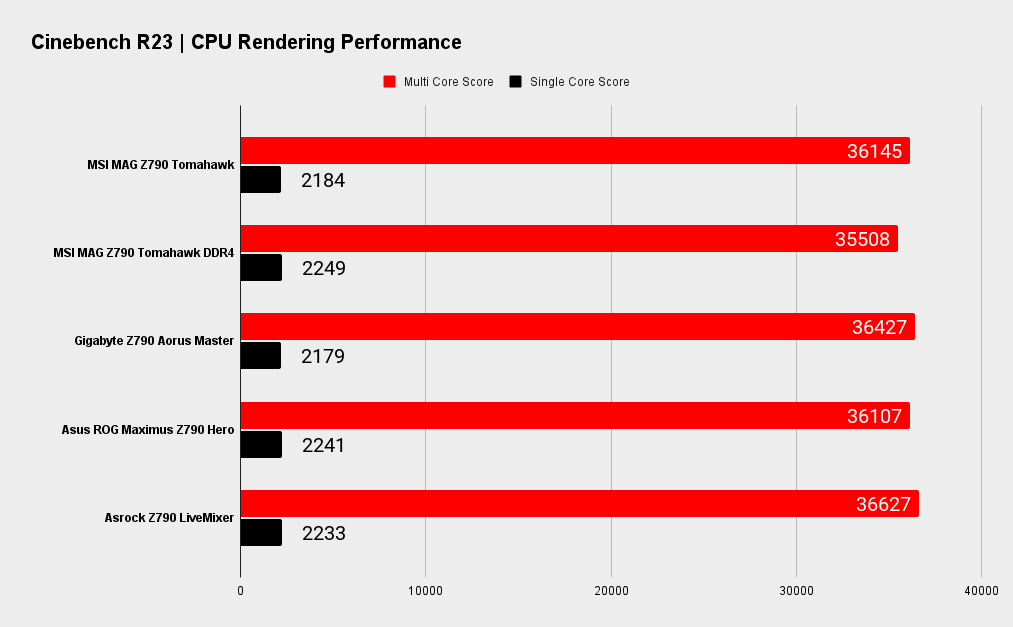
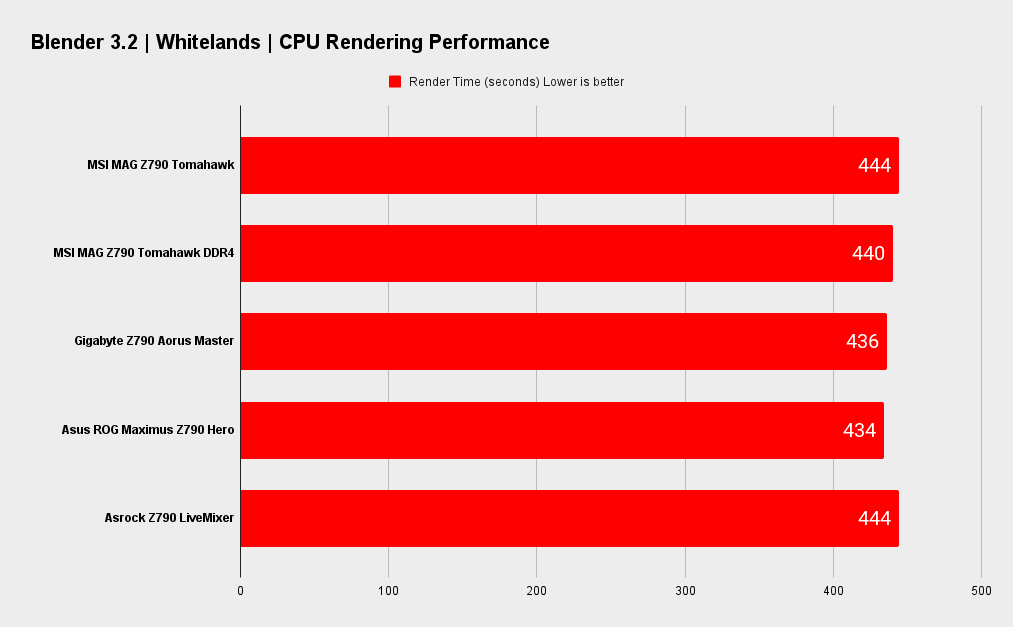
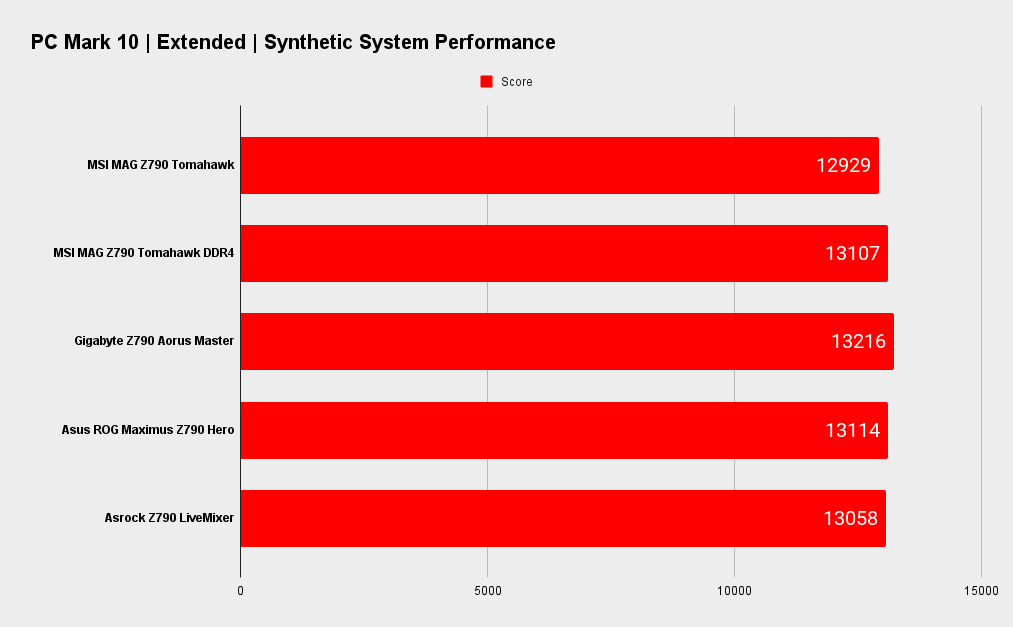
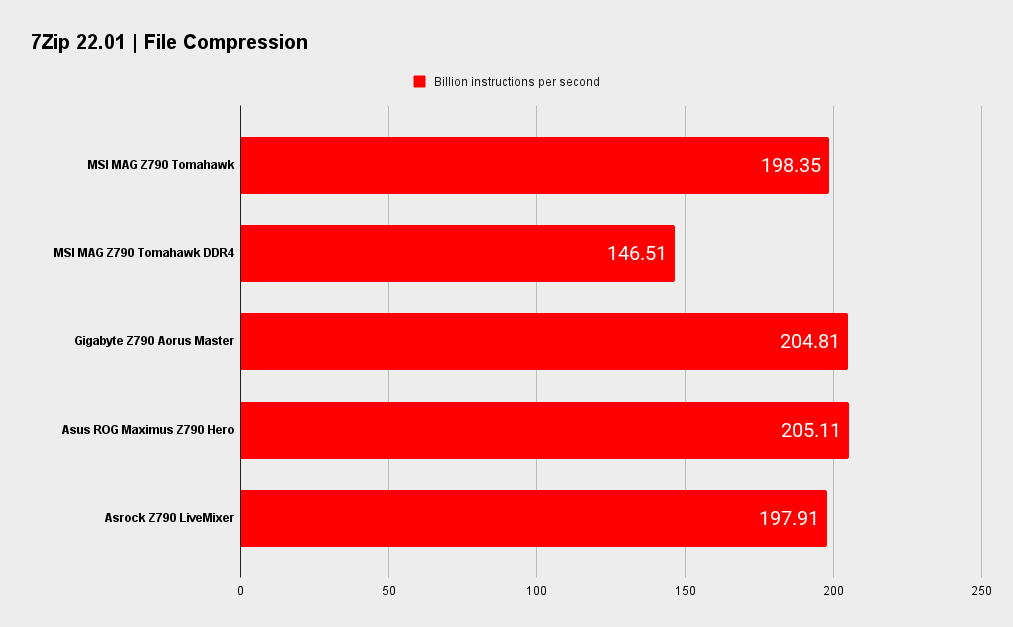
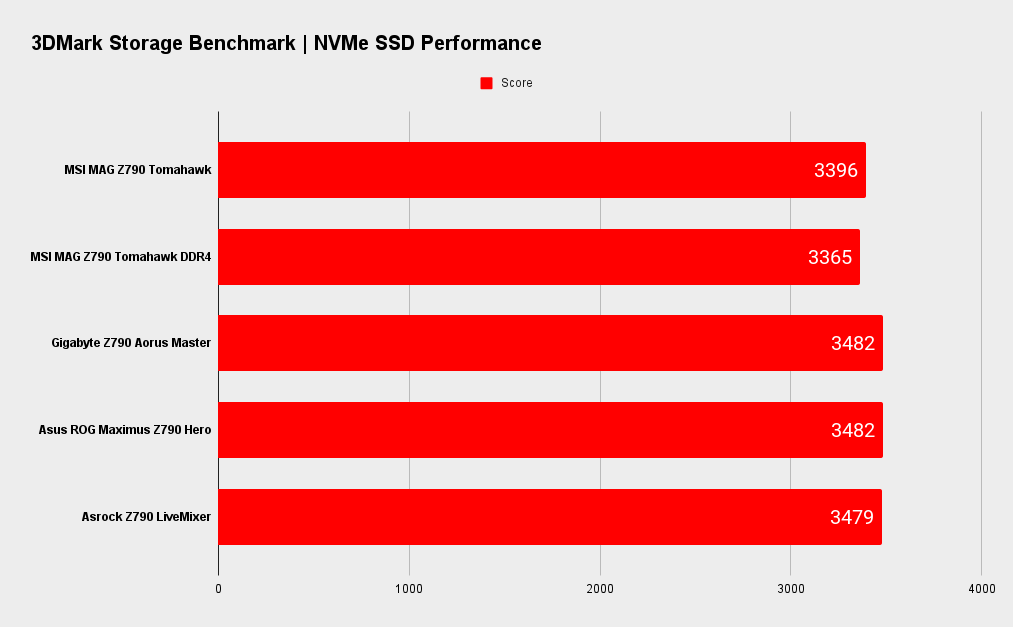
Gaming Performance
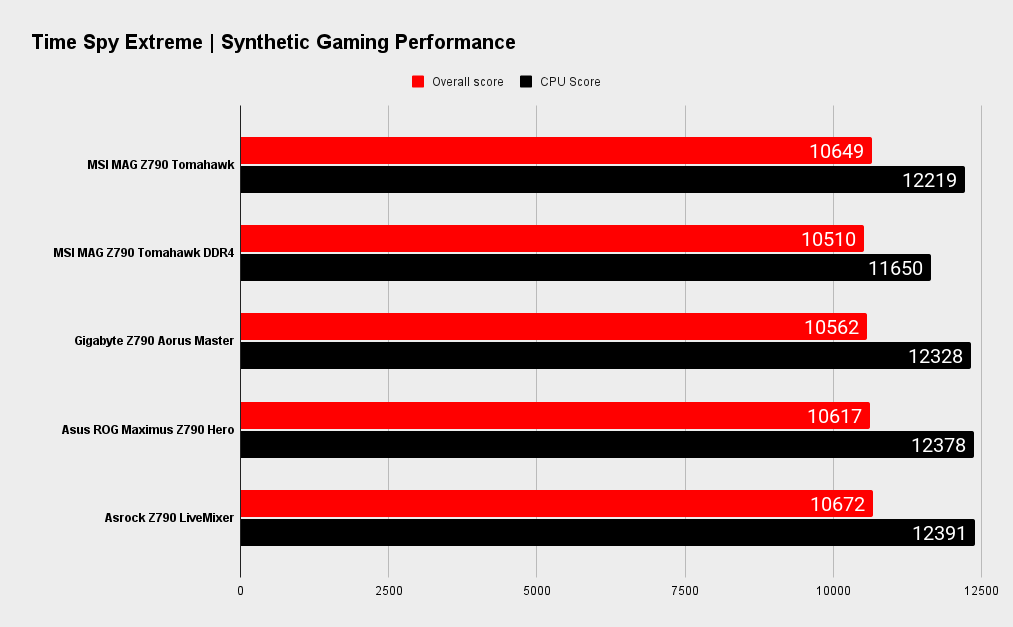
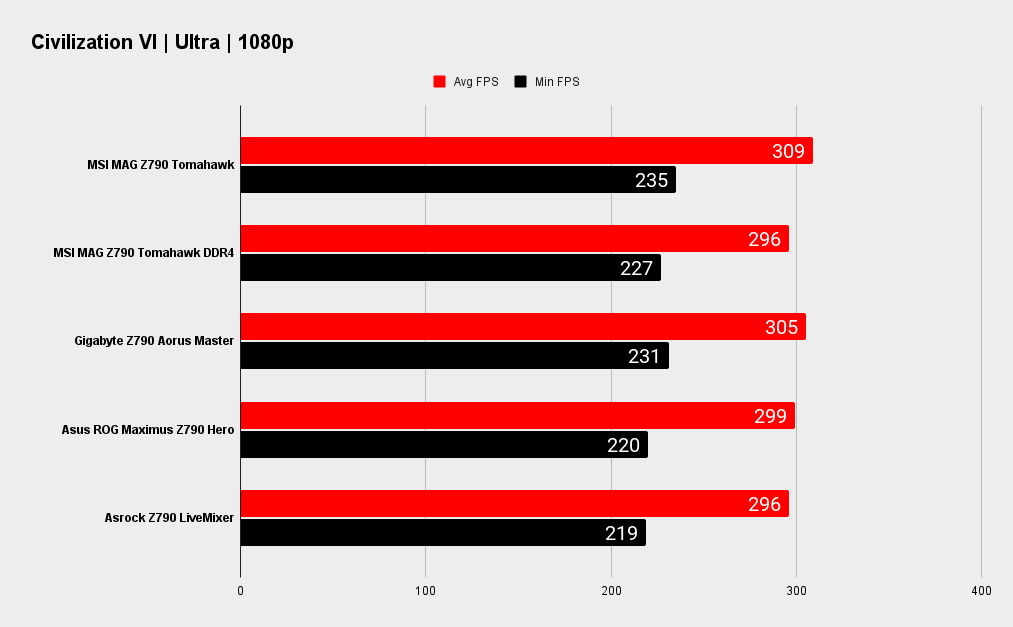



CPU: Intel Core i9 13900K
Graphics: Zotac GeForce RTX 3080 Ti AMP Holo
RAM: 2x 16GB G.Skill Trident Z5 DDR5-6000 C36
Storage: 2TB Seagate FireCuda 530
Cooling: Cooler Master PL360 Flux 360mm AIO
PSU: Corsair AX1000
I was fortunate to get my hands on both the DDR4 and DDR5 versions of the Z790 Tomahawk. That gives us a great opportunity to look at like-for-like systems with both types of memory. The takeaway—and it's a consistent takeaway when talking about memory—is that fast memory only helps in very specific situations. In this case I was using a good set of DDR4-3600 C14 memory, meaning the DDR4 results are near enough to as good as it gets unless you've got some really top shelf B-Die memory at 4000MHz+.
The Handbrake video encoding test benefits greatly, the file compression test even more so, while in other cases the differences are within a margin of error.
When it comes to gaming, the differences apply to specific games. Now that DDR5 prices have fallen, it makes sense to opt for the DDR5 Tomahawk over the DDR4 one. Of course, a better graphics card or CPU will deliver more tangible performance benefits.
When comparing the DDR5 Tomahawk to some other Z790 DDR5 boards, the results are generally within a margin of error. You'll get faster multithreading results if you leave your CPU's power limits unlocked, though power consumption will increase and you'll need very good cooling.
These days, with per core CPU turbo designs, using overclocking to evaluate a CPU is all but useless. Any mid-range board will handle a Core i9 13900K and if you overclock, you will hit cooling limitations before VRMs are overly stressed. Don't forget to keep the VRM cool though, as mentioned, the Z790 Tomahawk needs airflow to keep it from getting too hot. The Tomahawk needs a little bit of BIOS optimization to support fast memory. It's a small thing though, not many people will run 7600MHz+ on mid-range boards. Also, the Tomahawk doesn't officially support speeds beyond DDR5-7200, so it can't be faulted for not running 'bonus' speeds.

Thanks to inflation, supply chain issues and a little (or a lot) of greed, the pricing of motherboards and graphics cards is through the roof. That means finding a good value for money motherboard is vital, allowing you to divert money towards a faster GPU or CPU. If you make up a checklist of what you want from a motherboard, the MSI Z790 Tomahawk should have most of what you need. Things like USB4 or 10G LAN are what board makers use to justify the price of motherboards costing double the money of the Z790 Tomahawk.
If you make up a checklist of what you want from a motherboard, the MSI Z790 Tomahawk should have most of what you need.
The checklist is complete for most users. Wi-Fi 6E, 2.5G LAN, a strong VRM capable of handling 13900K, lots of USB ports including 3.2 Gen 2x2, a solid BIOS, and a discrete design ready to blend in with just about any build theme. Ask yourself if you need more? If you do, be prepared to take a step up in price.
Perhaps its lack of PCIe 5.0 M.2 support counts against and it requires good airflow if you subject it to heavy loads, but the MSI MAG Z790 Tomahawk is still a solid, feature-rich board that delivers a core feature set that will suit 95% or more of users. Do you need to spend more? I'd say you probably don't.
The MSI MAG Z790 Tomahawk Wi-Fi is proof that you don't need to spend really big bucks on a Z790 board unless you must have a specific feature. Other than missing out on a PCIe 5.0 M.2 slot, it's got just about everything you should realistically need.

Chris' gaming experiences go back to the mid-nineties when he conned his parents into buying an 'educational PC' that was conveniently overpowered to play Doom and Tie Fighter. He developed a love of extreme overclocking that destroyed his savings despite the cheaper hardware on offer via his job at a PC store. To afford more LN2 he began moonlighting as a reviewer for VR-Zone before jumping the fence to work for MSI Australia. Since then, he's gone back to journalism, enthusiastically reviewing the latest and greatest components for PC & Tech Authority, PC Powerplay and currently Australian Personal Computer magazine and PC Gamer. Chris still puts far too many hours into Borderlands 3, always striving to become a more efficient killer.


